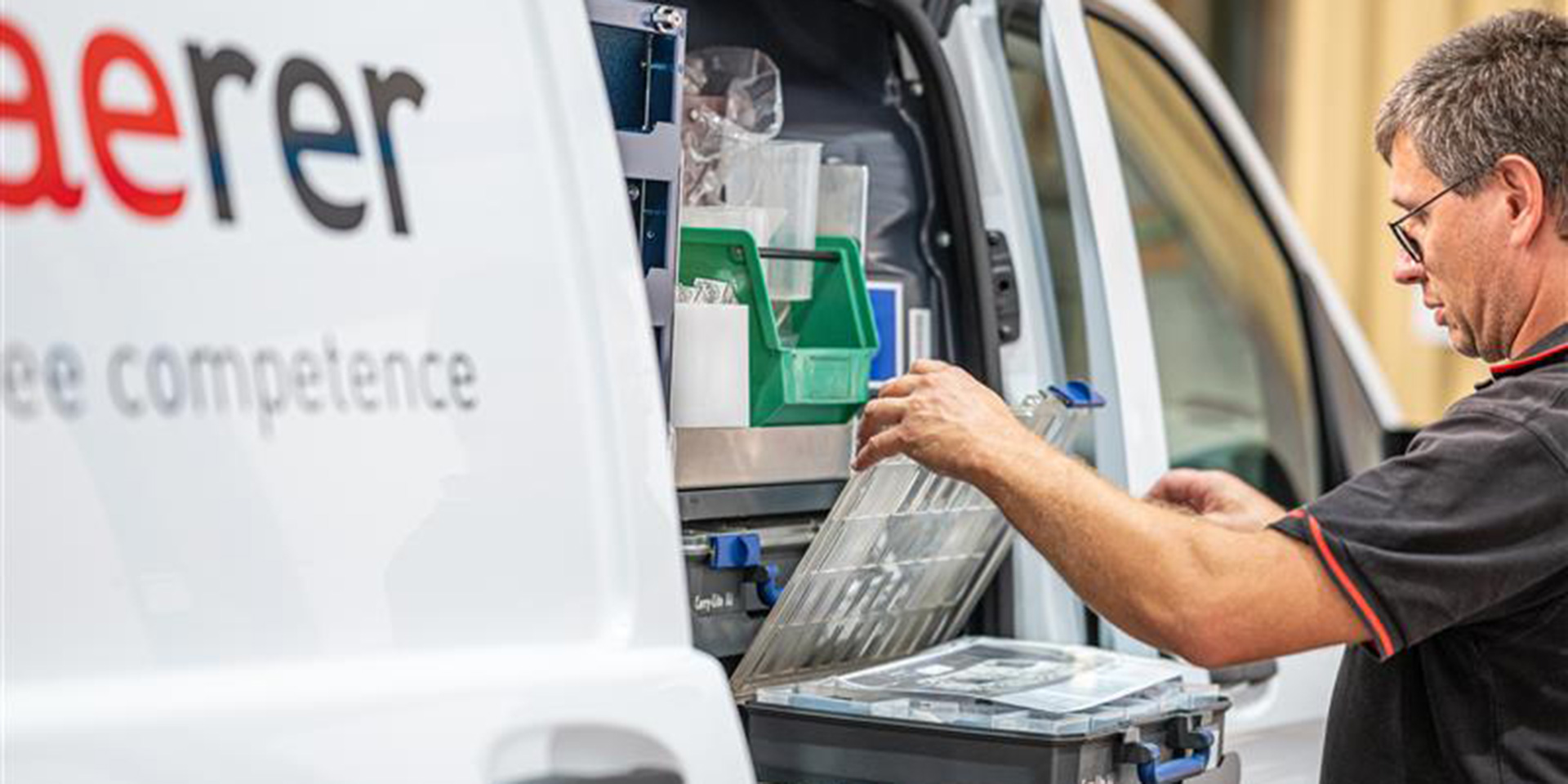Schaerer Service: It’s only complete with the “Swiss finish”
A lot has changed since Andreas Dellsperger started worked for Schaerer as a service technician in 1989: The employees in the service department are no longer only impressing customers with their technical knowledge. They also act as valued advisers to customers for all aspects of coffee preparation and are important ambassadors for Schaerer’s coffee expertise. Today, Andreas Dellsperger is Head of Service in Switzerland and is responsible for 45 employees, who work in seven teams covering seven areas throughout Switzerland. All service employees have around 850 parts on board, meaning they have everything needed for service, maintenance and repairs. In 95 per cent of all cases, even repairs only require one visit, no matter whether the coffee machine is from Schaerer or WMF. This service organisation at Schaerer is the only one in the group responsible for both Schaerer and WMF coffee machines. In this interview, Andreas Dellsperger reveals what customers can expect from the service team and how the reference manual “The Perfect Setting” developed by the Schaerer Coffee Competence Centre helps the service technicians do their job.
At what point in the purchasing process does the service department get involved?
More and more, the service technicians are involved as early as in the decision-making phase, so they are there for the entire purchasing process – and they can make suggestions to help customers find the best coffee machine for their needs. For instance, during an on-site visit, they check out the future site of the coffee machine together and the service employee gets all relevant information about the concept of the operation, and also about the beverage menu. At this point, new customers get to know the entire Schaerer team who will be there to support them in the future, from A to Z. Also: Since we restructured the service area two years ago, every customer has had “their own” technician, so the contact person always stays the same. This has several advantages: The employees always know the customer history, and they are directly responsible, meaning they have a much more personal relationship with the customers.
After the machine is installed – what are the first steps and what does the service department have to consider?
Since we are involved at an early stage, it is already clear at this point what the customer’s needs are. Are they only serving coffee, or is there a lot of emphasis on the quality of the milk foam? Are milk alternatives used? The service employee comes to the appointment prepared with this information. An important point is to determine the water quality on site before setting the different parameters such as coffee quantity, grinding level, water temperature, brewing pressure, etc. Since coffee is 98 per cent water, this is a significant factor for coffee quality. That is why all coffee machines are equipped with a BWT ion exchanger filter cartridge. After it heats up, the coffee machine is set – but the basic setting always follows the same principle, so this process usually does not take long. Basically, every visit then ends with what we call the “Swiss finish”: The coffee machine is perfectly set and ready to go, while the customer can experience the taste and beverage quality for themselves during a tasting.

After the basic installation, everything revolves around the perfect setting of the machine to achieve the best quality of coffee and milk foam. How does the service technician do this?
Today, it is a matter of course that a coffee machine can prepare a perfect café crème or espresso. An objectively reliable indicator of coffee quality is the TDS value. TDS stands for “total dissolved solids” and indicates whether the coffee beverage is perfect, or whether it is under-extracted or over-extracted. After the service employee has set the relevant parameters, the TDS measurement can be used to make a reliable assessment about the quality of the beverage that can be backed up with figures. However, to make sure that the beverage has the desired flavour profile, a TDS measurement is always accompanied by a tasting.
The focus is also more and more on the quality of the milk foam. Customers expect a clear separation and a shiny, creamy crown of foam. And this not only applies to cow’s milk, but also to vegan milk alternatives, since these products are quickly being added to more menus. That is why we are continuously expanding our knowledge about these beverages. Because in order to understand how to best foam various plant-based drinks, it is necessary to take into account the many aspects of food technology. For instance, an oat drink with a very low fat content behaves completely differently from cow’s milk when foamed. The same temperature also has different effects on the end product for various raw products. This is all very complex, and for the best cup of coffee, we need to give our service team the necessary knowledge
With the reference manual “The Perfect Setting”, the Coffee Competence Centre (CCC) has created a comprehensive collection to help the service team do their job. What do you think are the most important parts of this manual?
With this compendium, the CCC has created comprehensive documentation and instructions that provide the service team with extensive knowledge about coffee, milk (alternatives) and the perfect setting for Schaerer machines. As mentioned above, Schaerer service technicians are not only technical experts, but also know all about coffee and milk. In addition, the reference manual also gives us something to help us better explain certain principles to customers. An example of this is the TDS measurement mentioned above, which is an indicator of coffee quality as opposed to a purely subjective taste test. “The Perfect Setting” is also very important to us, as it embodies the idea of coffee expertise from the portafilter to the fully automatic machine. Of course, it is also a working tool for the service team, especially when it comes to special challenges that go beyond simply turning a screw. Last but not least, this compendium underpins the high value we at Schaerer place on coffee expertise. Anyone can say they care about this, but we have immortalised our comprehensive knowledge in writing.

Beyond this compendium, how does Schaerer make sure that its service is always up to date in terms of technologies, coffee expertise and coffee trends?
We are putting more and more into our coffee machines and, of course, we are also demanding more and more from the technology. That means the range of knowledge and the extent of the factors that have to be taken into account are becoming more and more extensive. That’s why every new service employee first attends a seven-week basic training course in Zuchwil, Switzerland. It includes extensive training about all aspects of coffee – the keyword being 360-degree coffee expertise. Refresher courses are also held regularly, which cover new trends.
In your experience: What are the most common reasons for a loss of coffee quality?
One of the most common causes of poor coffee quality is insufficient cleaning. If the machines are networked with our Schaerer Coffee Link digital solution, for example, we can track cleaning processes exactly and inform the customer or make recommendations for action. In order to give our customers the best support in all aspects of the cleaning process, we have developed the fully automatic Schaerer ProCare cleaning system. The add-on module stores cleaning powder in two bags and cleans the coffee and milk system for up to 100 cycles. This means that service staff no longer have to worry about cleaning for about three months – this is a big plus for hygiene as well as coffee quality. In addition to insufficient cleaning, incorrect storage of coffee beans also leads to lower quality. Open packages or bean hoppers that are too big for the actual demand are the main culprits here: The longer the coffee is exposed to light and air, the greater the loss of flavour. In addition, sometimes the roast blend for which the coffee machine was originally set is no longer used. This also has a negative impact on the taste of the coffee.
Beyond this compendium, how does Schaerer make sure that its service is always up to date in terms of technologies, coffee expertise and coffee trends?
We are putting more and more into our coffee machines and, of course, we are also demanding more and more from the technology. That means the range of knowledge and the extent of the factors that have to be taken into account are becoming more and more extensive. That’s why every new service employee first attends a seven-week basic training course in Zuchwil, Switzerland. It includes extensive training about all aspects of coffee – the keyword being 360-degree coffee expertise. Refresher courses are also held regularly, which cover new trends.

